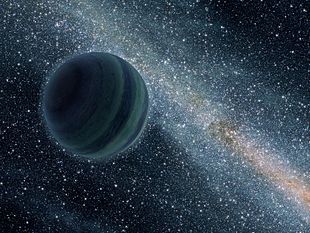
Artist's conception of a Jupiter-size rogue planet with the edge on disk of a spiral galaxy in the background. Image via the Wiki
I’ve posted on rogue planets and nomads and even a few wandering worlds that reach incredible speeds. A new study confirms what common sense would tell us: some of these restless worlds end up in alien solar systems:
(MSNBC) — Billions of stars in our Milky Way galaxy have captured rogue alien planets that once cruised freely through interstellar space, a new study suggests.Many wandering alien worlds, which were ejected from the solar systems in which they formed, likely find new homes with different suns, according to the study. The finding could explain why some alien planets orbit extremely far from their stars, researchers said.
“Stars trade planets just like baseball teams trade players,” study lead author Hagai Perets, of the Harvard-Smithsonian Center for Astrophysics, said in a statement.
This is exciting, for a lot of reasons. It means some of the weird distribution of planets we see in exosolar systems might be explained by an uninvited, massive guest screwing up the delicate arrangements. Best of all, it means some of our familiar planets could be rogues, which would bring up the possibility of visiting a planet from another solar system thousands of earlier than we otherwise might!

I recall a Poul Anderson story (one of the David Falkyn series, A
Sun Invisible) where it was claimed that single stars cannot capture rogue planets. I would be interested in seeing a discussion of the mechanism of capture. It seems logical that gravitational forces alone would only alter the rogue’s trajectory, not slow it sufficiently to be captured.
BTW, there were a couple of stories with the theme of rogue planets in that series.
I’m no astrophysicist, but couldn’t sufficiently large planets orbiting the destination star assist with the capture, if everything lined up right?
Yeah, the basic physics say that if you come in from outside the system, you automatically have enough energy to escape again. But another planet could aid in capture (this would require the helping planet to be kicked to a higher orbit or ejected from the system). Or, could a low-density planet be sufficiently slowed by drag against the particles in the star’s radiation? That might explain why we’re seeing gas giants so close to their stars – the radiation would be denser there. Granted, that’s the easiest kind of exoplanet to observe, but I don’t think we expected to see any gas giants in such low orbits before we started looking. Or… could it be tidal forces?
“the possibility of visiting a planet from another solar system thousands of earlier than we otherwise might!”
Who knows, maybe we already have and just don’t know it?
Wouldn’t such planets tend to have highly eccentric orbits and thus be very unappealing as real estate ventures?
In the Anderson story I referenced the orbits were eccentric. The mechanism suggested was that the rogues were captured when a giant star was condensing and friction from the nebula slowed them sufficiently for capture.
@ ^ john brown – & 1 too(?)
Guess its too late now but was that Poul Anderson story the novel Satan’s World (Corgi,12980, first published, 1968.) by any chance? That has a rogue planet passing close to a brightstar and melting – at least on its surface.
There’s also the planet of Baraf in the Starhammer novel by Christopher Rowley (Arrow books, 1987) which,well, becomes a rogue planet before being captured into orbit by one of the bright blue-hot stars of the Pleiades.
Great post, thanks. :-)
I wonder if some of the ice dwarf planets in the Edgeworth-Kuiper Cometary belt could fall into this category given their number and often elliptical orbits?
Planets such Eris, Sedna and “Buffy” otherwise known as 2004 XR190 (see : http://en.wikipedia.org/wiki/2004_XR190 ) among others.
Hopefully someone other than me is still reading this thread ..?
No?
Steve R, Satan’s World was a follow up story to the one I referred to which was called A Sun Invisible. The idea the Kuiper Belt objects might be extrasolar captures is interesting, although I believe there is an explanation related to the development of the solar nebula as the sun condensed to explain their presence. But hey, I’m no astrophysist, just an humble economist who grew up reading scifi.
@ ^ johnbrown : Cheers! Will have to see if I can find that one then.